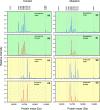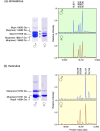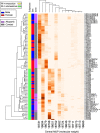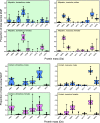Molecular heterogeneity in major urinary proteins of Mus musculus subspecies: potential candidates involved in speciation
- PMID: 28337988
- PMCID: PMC5364487
- DOI: 10.1038/srep44992
Molecular heterogeneity in major urinary proteins of Mus musculus subspecies: potential candidates involved in speciation
Abstract
When hybridisation carries a cost, natural selection is predicted to favour evolution of traits that allow assortative mating (reinforcement). Incipient speciation between the two European house mouse subspecies, Mus musculus domesticus and M.m.musculus, sharing a hybrid zone, provides an opportunity to understand evolution of assortative mating at a molecular level. Mouse urine odours allow subspecific mate discrimination, with assortative preferences evident in the hybrid zone but not in allopatry. Here we assess the potential of MUPs (major urinary proteins) as candidates for signal divergence by comparing MUP expression in urine samples from the Danish hybrid zone border (contact) and from allopatric populations. Mass spectrometric characterisation identified novel MUPs in both subspecies involving mostly new combinations of amino acid changes previously observed in M.m.domesticus. The subspecies expressed distinct MUP signatures, with most MUPs expressed by only one subspecies. Expression of at least eight MUPs showed significant subspecies divergence both in allopatry and contact zone. Another seven MUPs showed divergence in expression between the subspecies only in the contact zone, consistent with divergence by reinforcement. These proteins are candidates for the semiochemical barrier to hybridisation, providing an opportunity to characterise the nature and evolution of a putative species recognition signal.
Conflict of interest statement
The authors declare no competing financial interests.
Figures







Similar articles
-
Species-specific expression of major urinary proteins in the house mice (Mus musculus musculus and Mus musculus domesticus).J Chem Ecol. 2007 Apr;33(4):861-9. doi: 10.1007/s10886-007-9262-9. J Chem Ecol. 2007. PMID: 17333372
-
Reinforcement selection acting on the European house mouse hybrid zone.Mol Ecol. 2011 Jun;20(11):2403-24. doi: 10.1111/j.1365-294X.2011.05106.x. Epub 2011 Apr 26. Mol Ecol. 2011. PMID: 21521395
-
Do changes in gene expression contribute to sexual isolation and reinforcement in the house mouse?Mol Ecol. 2017 Oct;26(19):5189-5202. doi: 10.1111/mec.14212. Epub 2017 Jul 16. Mol Ecol. 2017. PMID: 28626946
-
Comparative study of the molecular variation between 'central' and 'peripheral' MUPs and significance for behavioural signalling.Biochem Soc Trans. 2014 Aug;42(4):866-72. doi: 10.1042/BST20140082. Biochem Soc Trans. 2014. PMID: 25109970 Review.
-
Multiple roles of major urinary proteins in the house mouse, Mus domesticus.Biochem Soc Trans. 2003 Feb;31(Pt 1):142-6. doi: 10.1042/bst0310142. Biochem Soc Trans. 2003. PMID: 12546672 Review.
Cited by
-
Rapamycin Treatment Alleviates Chronic GVHD-Induced Lupus Nephritis in Mice by Recovering IL-2 Production and Regulatory T Cells While Inhibiting Effector T Cells Activation.Biomedicines. 2023 Mar 20;11(3):949. doi: 10.3390/biomedicines11030949. Biomedicines. 2023. PMID: 36979928 Free PMC article.
-
Urinary protein analysis in mice lacking major urinary proteins.Exp Anim. 2021 Aug 6;70(3):406-411. doi: 10.1538/expanim.21-0010. Epub 2021 Apr 20. Exp Anim. 2021. PMID: 33883349 Free PMC article.
-
Identification of potential chemosignals in the European water vole Arvicola terrestris.Sci Rep. 2019 Dec 5;9(1):18378. doi: 10.1038/s41598-019-54935-z. Sci Rep. 2019. PMID: 31804568 Free PMC article.
-
Proteome characterization of used nesting material and potential protein sources from group housed male mice, Mus musculus.Sci Rep. 2019 Nov 26;9(1):17524. doi: 10.1038/s41598-019-53903-x. Sci Rep. 2019. PMID: 31772257 Free PMC article.
-
Do all mice smell the same? Chemosensory cues from inbred and wild mouse strains elicit stereotypic sensory representations in the accessory olfactory bulb.BMC Biol. 2021 Jun 28;19(1):133. doi: 10.1186/s12915-021-01064-7. BMC Biol. 2021. PMID: 34182994 Free PMC article.
References
-
- Butlin R. K. & Ritchie M. G. In Behaviour and evolution (eds Slater P. J. B. & Halliday T. R.) 43–79 (Cambridge University Press, 1994).
-
- Coyne J. A. & Orr H. A. Speciation (Sinauer Associates, Inc., 2004).
-
- Smadja C. & Butlin R. K. On the scent of speciation: the chemosensory system and its role in premating isolation. Heredity 102, 77–97 (2009). - PubMed
-
- Monti L., Genermont J., Malosse C. & Lalanne-Cassou B. A genetic analysis of some components of reprouctive isolation between two closely related species, Spodoptera latifascia (Walker) and S. descoinsi (Lalanne-Casou and Silvain) (Lepidoptera: Noctuidae). J Evol Biol 10, 121–134, doi: 1010-061X/97010121-14$1.50+0.20/0 (1997).
Publication types
MeSH terms
Substances
Grants and funding
LinkOut - more resources
Full Text Sources
Other Literature Sources

